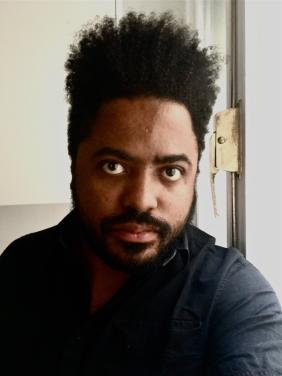
Kiluanji Kia Henda was born in 1979 in Angola. He lives and works in Luanda, Angola. Kia Henda's interest in the visual arts comes from having grown up in an environment of photography enthusiasts. A connection with avant-garde music and theatre was part of his conceptual training, as was his collaboration with artist collectives in Luanda. His work was included or commissioned over the last years in: Serpentine Galleries, London; Haus der Kulturen der Welt (HKW); Centre George Pompidou, París; Migros Museum, Zurich; International Film Festival of Rotterdam; 2nd Lubumbashi Biennale, Lubumbashi; 12th Gwangju Biennial, Gwangju; Tate Modern, London; Guggenheim Museum, Bilbao; 3rd New Museum Triennial, New York; 11th Biennale of Dakar, Dakar; Bergen Assembly – 1st Bergen Biennial; Tamayo Museum, Mexico DC; 29th São Paulo Biennale (2010); 52nd Venice Biennale - African Pavilion (2007), among others. In 2012, Kia Henda won the National Prize for Culture and Arts, awarded by the Angolan Ministry of Culture, and in 2014 he was selected among 100 Leading Global Thinkers by the prestigious US magazine Foreign Politics. In 2017, he won the Frieze Artist Award and in 2019 he was selected for the Unlimited Basel project.
Othello's Fate (Act I, II, III, IV and V), 2013
Digital print on matt paper mounted on aluminium
110 x 170 cm
Courtesy: Galeria Filomena Soares and the artist
Though Othello, Shakespeare’s tragic protagonist, has usually been described as a tale of jealousy, race is also an overarching theme: it is because Othello is a Moor that he and Desdemona must elope; it is because Othello has internalised the racial abuse to which he is constantly subjected that he falls for Iago’s intrigue. ‘Haply, for I am Black’, Othello reasons, believing Desdemona to have committed adultery, sealing everyone’s fate, and – because of the misrecognition integral to tragedy – never realising that it is he rather than his wife who looks upon himself through the eyes of another. In a suite of five photographs entitled Othello’s Fate (2013), part of the ongoing project Self-Portrait as a White Man (2010–), Kia Henda stages a naked Othello against a late-Rococo backdrop thematising the black male nude as the forbidden vision of Western art.
Phantom Pain – A Letter to Henry A. Kissinger, 2020
HD Video, color, sound, 08:30
Courtesy: Galeria Filomena Soares and the artist
The short film Phantom Pain – A Letter to Henry Kissinger is a video letter to the former US Secretary of State Henry Kissinger. Drawing on autobiography, the film is shot entirely on the street where the artist Kiluandji Kia Henda was also born and raised. By visiting the cinema, the church and the orthopaedic centre, all located in the same street, Kia Henda talks about his childhood memories during the long years of the Angolan Civil War (1975–2002), and about the eminent influence of the Cold War in this conflict. The short film addresses the perverse contribution the US made to maintaining and intensifying the war in Angola, as testified to by the book In Search of Enemies written by the former C.I.A. officer and Chief of the Angola Task Force in 1975, John Stockwell.
La conquista del reino sin memoria (con Jeanne Rolande), 2023
Inkjet print on fine art paper, 93 x 140 cm
New commission
This portrait is part of a series I have been developing since 2010, which examines the presence of the African diaspora in Europe, both from a historical and a contemporary perspective, referencing the plight of recent emigrants.
For this specific portrait, taken in San Sebastian, I sought to reference the city’s relationship with the trade of enslaved people, uprooted from Africa, who via their labour in South American plantations, contributed to the prosperity of the city during an extended historical period, whose afterlive is still apparent today.
The activist Jeanne Rolande posed for a photograph inside the grand hall of the city hall building. Her defiant pose has a dual meaning; on the one hand it seeks to legitimize the presence of emigrant communities within structures that represent institutional power – hence her regal posture – on the other hand, her portrait evokes mourning rituals as a form of resistance. One of the elements in the portrait is the pampas grass bouquet, which Jeanne holds with her right hand as if raising a gun. Pampas grass is a species that was brought from the South American colonies, and is today considered an invasive species. Capable of outgrowing and displacing native species, the threat this grass poses contrasts with its underestimated capacity to decontaminate soils.
At a moment when the need to decontaminate the soil has become as urgent as the need to decolonize the mind, and there is likewise a need to restructure the mechanisms that inhumanely wield power over us, this portrait condenses the daily struggles of activists like Jeanne into an image of defiance that, although symbolic and fictional, will nevertheless contribute to quenching the thirst for freedom, social rights and hope among Europe’s historically oppressed minorities.
—Kiluanji Kia Henda